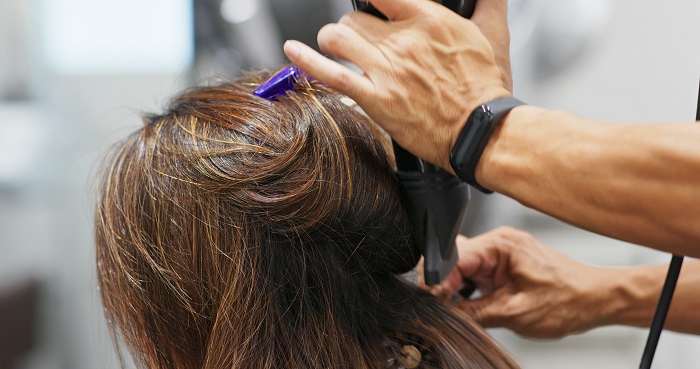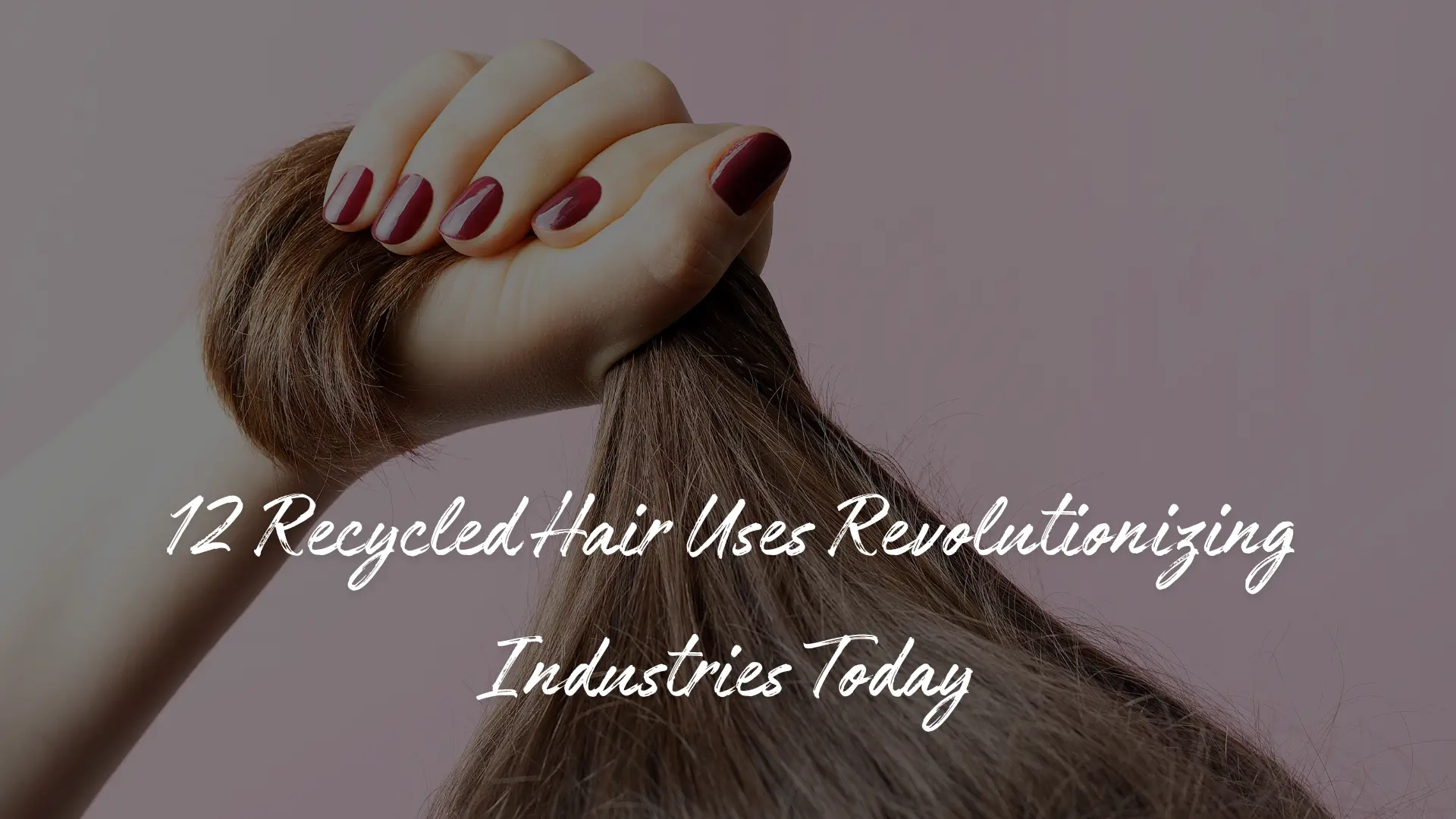Recycled hair uses are many and are rapidly taking long strides in the recycling industry. Every single person in this world has a problem with hair, and hair fall is one of them. Hair, in its natural form, grows, and we often do different haircuts and styles, which gives us beautiful change. Hair can be long or short, braided or straight, waved or curled, natural or color dyed!! There’s no limit! You can play with your hair as you want. But what about the hair that gets discarded after a haircut? Have you ever thought about where these hairs go? How do all these hairs are disposed of? Today’s blog is going to answer these questions. Come on, guys, let’s explore in detail waste hair recycling.
Why are hair considered as waste?
Human hair is considered a waste in most parts of the world. It is generally found in municipal waste streams in almost all world cities. Villages and areas with low population density throw away hair in their surroundings. Then it slowly undergoes a decomposition process for several years. They eventually returned to their constituent elements, namely, carbon, nitrogen, and sulfur. In urban areas or areas with high population density, it accumulates in large amounts in solid waste streams. Sometimes, it chokes the drainage system, which further causes many more problems. Due to slow degradation, it stays in landfill for a very long time. Therefore, occupying large volumes of space.
Over time, leachate from these dumps increases the level of nitrogen concentration in the water bodies. Further, causing a problem of eutrophication in water bodies. Burning of human hair or the waste piles containing them is a common practice observed in many parts of the world. These produce a foul odor and toxic gases such as ammonia, carbonyl, sulfides, hydrogen sulfides, sulfur dioxide, phenols, nitriles, pyrroles, and pyridine. These make air toxic to breathe. Waste hair in open landfill generates hair dust which causes discomfort to people living near them. If inhaled in large amounts, it can result in several respiratory problems. Oils, sweat, and other organic matter sticking to the hair rot over time. These all become a source of foul odor and also a breeding ground for pathogens.
The best way to address such problems is to develop recycling methodologies that utilize waste hair as a useful resource. In addition, it helps to reduce waste and also contributes to the economy. Human hair is a potential material resource. It has many advantages. It is completely biodegradable, renewable, and available everywhere. In case you need help from experts on recycling waste hair, you can connect with one of our recycling consultants.
So let’s see different recycled hair uses in various industries!
Explore Hair Waste Recycling Solutions
Find top machinery, plants, tools, resources, companies, and consultancy for comprehensive hair waste recyling needs.
Recycled hair uses and applications

1. Cosmetic and accessory industries

Waste hair can be recycled for hair extensions, wigs, eyelashes, mustaches, beards, and many more beauty accessories. This is one of the most ancient and currently the largest human hair-based industries. It has a constantly increasing scale due to the global expansion of the fashion industry. In eastern countries, such products primarily catered to the theatre world, but in the west, they evolved significantly with the fashion industry. This application predominantly uses good quality long hair of almost all colors. In addition, hair in which all strands have surface scales in the same direction (similar to the hair on the human body), known as Remy’s hair, is preferred because it tangles much less during work. Non-Remy hair is often used after chemically removing the outer scale containing the cuticle layer. Pure Remy hair products are expensive. At the same time, those with non-Remy hair or human hair mixed with other fibers are cheaper.
2. Test material for hair care products
Recycled hair is used as test material for new formulations of shampoos, oils, conditioners, dyes, and so on. These tests use the hair of different colors, range of curliness, and different levels of damage. Recycled hair uses include hair care research, product manufacturing, hair styling, etc.
3. For Making Cosmetic Brushes
Scales on hair can hold cosmetic powder particles easily. So it can be applied uniformly on the skin or a surface. Therefore, human hair is used in making cosmetic brushes. Almost all kinds of straight hair can be used for brushes.
4. Fertilisers

Human hair is one of the highest types of nitrogen-containing (approximately 16%) organic material. Because it is predominantly made up of (nitrogen-containing) proteins. For comparison, cattle dung contains only ∼0.2-0.3% nitrogen. In addition, human hair also contains sulfur, carbon, and 20 other elements, which are essential for plants. In the atmosphere, hair decomposes very slowly, but moisture and keratinolytic fungi present in the soil, animal manure, and sewage sludge can degrade hair within a few months.
In traditional Chinese agriculture, human hair was mixed with cattle dung to prepare compost that was applied to the fields in the winter season. In some communities of India, hair has been used directly as fertilizer for many fruit and vegetable crops and in making organic manures. Recent experiments on horticulture plants show the direct application of human hair. It helps the soil to provide the necessary plant nutrients for over two to three cropping seasons. A company named SmartGrow has popularised the fertilizer use of human hair in the USA by selling it in the form of hair mats for potted plants. Small entrepreneurs in the USA are also promoting hair as a fertilizer by packaging it in various user-friendly forms, such as in tea bags. By mixing human hair with cattle dung and feeding worms on the mixture, it is also possible to make good quality vermicompost within a period of about two months. Obviously, we all know the benefits of vermicompost. Non-Composted hair, however, has many advantages over composted hair because composting can lead to some loss of nitrogen.
While the biological decomposition of hair takes a few months, human hair can also be decomposed within a few hours by chemically hydrolyzing it at high temperatures in acidic or basic solutions. The hydrolyzed solution, which mainly consists of amino acids with some fatty acids and nucleotides, can be used as a liquid fertilizer after neutralization. Experiments using this hydrolyzate as foliar spray show enhancement of the chlorophyll content as well as biomass in spinach and wheat plants. Application of these solutions to soil also shows improvements in the color and size of Amaranthus dubius and hot pepper plants. Experiments on the hot pepper plants also show increased diversity of soil-intrinsic bacteria. It significantly reduces the spread of wilt disease in these plants caused by the bacterium Ralstonia solanacearum. Long-term impacts of this use, however, need to be assessed. Any hair without toxic contamination can be used for fertilizers. Finely shredded hair is considered better for faster decomposition.
Struggling with hair waste recycling issues? Connect with top consultants specializing in recycling.
Connect Now5. Reinforcement of Construction Materials
Due to high tensile strength and high friction coefficient, human hair has been used for reinforcing clay-based constructions. In rural areas like Uttar Pradesh and Madhya Pradesh, countries like India and Europe, human hair-clay mixture, along with other binders, is used in plastering house walls, lining ovens, making wheels, and so on. The addition of hair significantly reduces cracking and prolongs the life of these structures. Research shows that human hair reinforcement enhances structural strength and the thermal insulation capacity of clay structures. However, such clay-based constructions are now decreasing in rural areas. They are gaining more importance in sustainable architecture.
Human hair reinforcement also reduces the cracks in cement mortar caused by plastic shrinkage by as much as 92% and increases the compressive strength of fly ash/cement concrete by over three times. This improved fracture resilience and strength of hair-reinforced cement and fly ash concrete is highly useful in high-pressure-bearing structures such as petroleum wells and bridges. Any kind of hair can be used in these applications. For detailed information on this, connect with our construction consultants here.
6. Pollution Control and Remediation
Have you ever wondered, hair which itself is a part of waste in the environment can be used to control environmental pollution. Let’s see in detail!
7. Oil-Water Separation and Oil Spill Remediation
Human hair surface has a higher affinity towards oil than water. This property is beneficial in oil-water separation. Mats of human hair have been used to clean up coastal oil spills in the Philippines and the USA. In this method, oil can be recovered by wringing out the hair, which can then be reused up to 100 times. These are advantages that are not present in other oil spill remediation methods. With this method, up to 98% of the spilled oil can be recovered.
The oily hair can then be used to grow oyster mushrooms, which decomposes the oil. The hair then left can be composted. Human hair can also separate emulsified oil in water, which is very expensive to clean by other methods. This property can greatly help in cleaning effluent from industries such as oil refineries. Any kind of hair can be used in these applications except with toxic contamination, which can contaminate the water body.
Find and connect with leading companies specializing in recycling solutions.
Get Connected Today
8. Removing Phenols, Aldehydes, Dyes, and Heavy Metal Pollutants from Water
Recycled hair can be used to absorb several chemicals and heavy metals from aqueous solutions. Experiments show that human hair can absorb organic pollutants such as formaldehyde and phenol and heavy metals such as mercury (Hg), copper (Cu), cadmium (Cd), and silver (Ag) from aqueous solution. The capacity for metal absorption can be enhanced by pretreating the hair with an alkali. Powdered human hair has good absorptive capacity for Ni (II) and Cr (VI) ions at acidic pHs and partially burned human hair shows selective absorption of mercury (Hg2+ ) and silver (Ag +) ions over cobalt (Co2 +), copper (Cu2 +), and iron (Fe3 +). Thus, human hair can be used as a low-cost adsorbent for the purification of polluted waters. The recycling or disposal of contaminated hair, however, can become a problem. Partial recovery of absorbed metals from the hair has been explored, but further research is needed to develop recovery or recycling methods for such chemicals from the contaminated hair.
9. Pharmaceuticals and Biomedical Applications

Human hair proteins typically contain 20 essential amino acids. It can be extracted by complete hydrolysis of hair. Some of the amino acids obtained in good yield from human hair are L-cysteine, L-leucine, L-isoleucine, and L-valine. L-cysteine and its chemical derivatives are used in many cosmetics and pharmaceutical formulations. For example, L-cysteine is used for permanent wave lotions and wound healing formulations. While one of its derivatives, N-acetyl L-cysteine (NAC), is used to treat conditions such as chest congestion and acetaminophen poisoning.
Hair from certain demographic regions is better for extracting certain amino acids. For example, black hair from Asia has more cysteine than blonde hair. In addition, hair that is chemically not altered by any styling treatment is better because some of these treatments can change the chemical structure of the hair. For example, the increasing trend of permanent waving in some parts of China has made cysteine extraction from their hair difficult. Connect with our biomedical waste consultants for consultation on management of biomedical waste.
10. Stuffing Toys, Mattresses, and Other Household Items
Due to its elasticity, cushiony nature, and good thermal insulation properties, human hair has been used to stuff household items such as hair-pin cushions, toys, furniture, mattresses, quilts, jackets, and many more. In pin cushions, natural oil of the hair prevents the rusting of pins and needles. For toys and mattress stuffing, human hair is usually mixed with cotton or other fibers.

Explore the best recycling machinery and plants for your industrial needs.
Connect Today11. Fabrics
High thermal insulation, elasticity, and good tensile strength also make human hair helpful in making various kinds of fabrics. In Arunachal Pradesh, India, people have traditionally been making fabrics by mixing human hair with yak hair, nettle fiber, and cotton. In China, human hair, yak hair, and cotton are used to make interlining cloth for coats and jackets. In these applications, mostly cotton yarn is used as a warp, and the hair is used as a weft.
Human hair blended with animal fibers is used for making blankets in Panipat, India. In fact, hair can be recycled into ropes. Due to good tensile strength, human hair has been used to make ropes in many cultures, for example, to lift heavy beams, construct bells in Japanese temples, and for household purposes by Native Americans. These ropes are still valued for horse riding.
12. Artwork
Two art traditions evolved worldwide and used human hair as the key material. The first is hair embroidery (called Moxiu in Chinese). In China, between the 7th and 13th centuries, women made images of Buddha with their own hair. This art revived again in the late 20th century and now has surpassed its past in color and variety. Earlier, natural shades of hair were used, but now dyed hair is also used. The tradition has even developed a rich school of portrait embroidery. The second tradition is hair work; it evolved in the 19th century in Scandinavian countries and then spread to England and America. Hairwork included intricate jewelry, flowers, buttons, brooches, and so forth, made of human hair with gold and resins. It also included the craft of hair embroidery. Dissolved hair and finely chopped hair mixed with oil were used as paint. Socially, hair work pieces were mainly associated with special affection, such as between spouses and in memories of a dead person (with hair work pieces made from the deceased person’s hair). Increasing symbolism of hair work with death and mourning led to fading of this tradition by the early 20th century. However, recently, there has been increasing interest in reviving this art. A society has been established to connect and promote the hair work of artists in the world.
Conclusion
“Invest in your hair; start recycling.”
Through this blog, we have seen many recycled hair uses. These applications range from agriculture to medicine to engineering industries. In addition, many new areas are being explored in scientific research. Large-scale implementation of these uses, however, requires several environmental, social, and economic considerations. The existing trade in human hair, which has evolved around some of these uses over centuries, provides several important lessons. The collection of hair can be based on many diverse systems driven by both economic and non-economic factors. Some of its products have sustained large markets in spite of competing products because of their better properties. This trade has provided livelihoods in many parts of the world but has also caused concerns about the ethical collection of hair, environmental and health safety in the hair processing industries, and product safety for consumers. Based on a systemic approach to the complete value addition chains from collection to consumption, most of these concerns can be addressed. Hence the waste hair recycling industry can be a sustainable industry with innovative technology.









